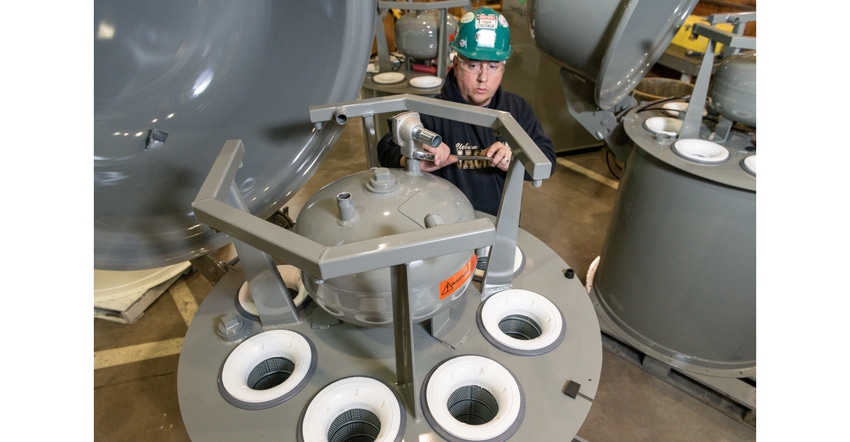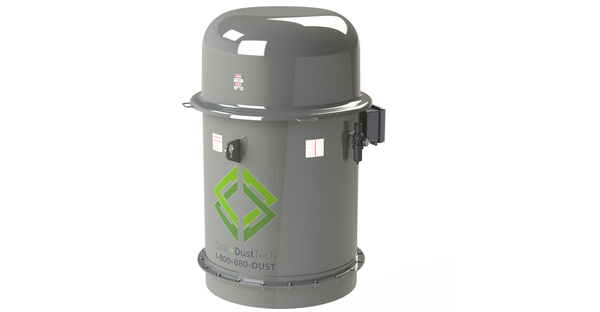Routine dust collection system maintenance can make all the difference to improve uptime, productivity, and safety in your operations.
February 15, 2023

Bill Werra, president, C&W DustTech
No matter the application, dust collection is critical to a facility’s operations – especially in heavy industries like ready-mix, concrete, cement production, and mining. A properly sized and installed dust collection system has the opportunity to make a major positive impact on your company’s bottom line. It can help increase employee morale, prevent equipment damage, eliminate the risk of regulatory fines, and more. Simply installing a dust collector, however, is not enough to ensure optimal system performance.
This article will help you understand how routine system maintenance can make all the difference to improve uptime, productivity, and safety in your operations.
Don’t Put Your Operation at Risk
When owning and operating a dust collection system, it is critical to establish an ongoing maintenance program that keeps your system running at peak performance. In fact, forgoing regular system maintenance can put your people, processes, and assets at risk. These risks could include:
Fines or disciplinary action: A poorly functioning system can lead to high amounts of fugitive dust in the air, leading to trouble with regulatory bodies – including the Environmental Protection Agency (EPA), Occupational Safety and Health Association (OSHA) or Mine Safety and Health Association (MSHA) – that set safety guidelines and standards for dust emissions.
Energy waste: Clogged filters or leaky ducts can lead to inefficient system operation.
Combustion: For some materials, dust buildup can pose a major combustion risk if left unchecked.
Increased repair costs: Both for your dust collector and other equipment damaged by an accumulation of dust on surfaces and inside machinery
Health problems: Fugitive dust--at any level--can pose a respiratory or health risk to your employees and your community, especially known hazards like silica dust found generally in stone, rock, sand, gravel, and clay.
Maximizing Your Dust Collection Investment Long-Term
A dust collection system is not just a one-time expense. It is an investment that should be evaluated with a long-term return on investment (ROI) in mind. Regular, proactive maintenance and proper system operation ensure that you achieve this return, while protecting what matters most.
Fugitive dust collected throughout your production process is often dirty, heavy, and abrasive. It takes a continuous toll on your equipment and the emotional and physical well-being of your employees. It also jeopardizes your investment in your plant--and community. Because of this regular wear and tear, continuous monitoring of your system's health, and a commitment to ongoing maintenance will protect and preserve your investment. Ultimately, this will lead to happier employees, cleaner environments, and better business results.
Properly cleaning, maintaining, and replacing your collector, filters, fans/blowers, ducting, and other components will help eliminate escaped emissions and production stoppages, while ensuring that your system continues to perform at its highest level.

Create Your Maintenance Plan
A properly maintained dust collector or full dust collection system can offer more reliability while mitigating serious safety and reputational risks for your business. From the beginning, it is critical to identify the steps your team should take to ensure your plant stays up and running – and your people stay safe.
1. Establish a Baseline
Any maintenance program should begin with a thorough understanding of a system’s “normal” operation. Note readings where possible (i.e. your baseline magnehelic gauge reading) to set your benchmarks and help you more readily identify when your system is performing sub-optimally.
2. Determine a Schedule
Daily, weekly, monthly, and annual maintenance includes regular visual inspections, level checks, filter cleaning, and timely component replacement and other tasks help identify and fix emerging issues and avoid unplanned downtime. If you’re unsure of where to begin, working with your dust collector manufacturer or dealer is a great place to start. That team will help you understand how to build a schedule that suits your system while helping you understand the nuances of maintenance – like the importance of replacing filter media at the same time to avoid faster wear and tear.
3. Gain Your Team’s Buy-in
Make sure your whole team understands the importance of the program--including the risks of not understanding its importance--and commits to owning the tasks involved.
4. Ensure Employee Safety
For employees responsible for executing your maintenance plan, ensure that they always follow OSHA and your company’s Safety Procedures and Lock Out / Tag Out procedures when maintaining your dust collector. With the presence of high air pressure, moving parts and high electrical voltage, it is critical to be aware of how to keep you and your team safe.
Maintenance Schedule Example: Fans & Blowers
Fans and blowers are one of the most critical components in a high-performing dust collection system, because they effectively move air throughout the entire unit and system. While quality construction, materials, and design determine the lifespan of fans and blowers, nothing lasts forever. That’s why it’s important to conduct regular maintenance checks on your system.
The following is a recommended maintenance schedule to keep your fans and blowers running at maximum efficiency.
Weekly
Blowers and Belts: Inspect for proper belt tension and excessive wear.
Monthly
Fan Bearings: Lubricate (assuming 10-hr/day operation).
Blower Fans: Look for buildup on the front and backside of the fan; inspect for excessive vibration*
*Dust buildup and excessive vibration can cause cracked housings and wheels.
Make Your Impact on the Environment
No matter the makeup of your system, making regular system maintenance a priority is the only way to safeguard your system’s efficiency, effectiveness, and reliability. Even dust collectors engineered to the highest performance standards are subject to dust buildup and excessive wear. Investing in ongoing maintenance will ensure that you’re maximizing your long-term return on your essential system investment.
Talk to expert partners that will work with you to create a customized solution that not only meets your needs, but also complies with regulations governing air quality in your region. Together, let’s create a better, safer world.
Bill Werra is president, C&W DustTech (Alvarado, TX). For more information, call 800-880-3878 or visit www.cwdusttech.com.
You May Also Like


